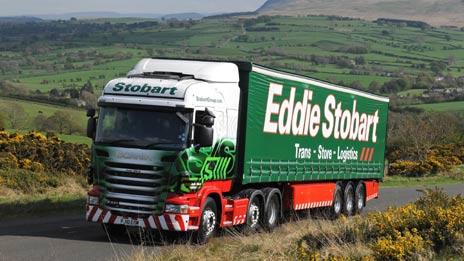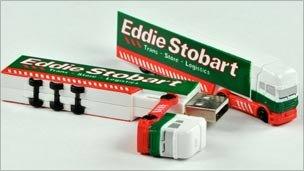How did Eddie Stobart become so famous?
- Published
- comments

For many people, lorry legend Edward Stobart changed the face of freight and built up one of Britain's biggest brands. But how did he create such a phenomenon?
Stop people in the street and ask them to name a road haulage company and it is a safe bet a sizeable number will come up with Eddie Stobart.
Over the past couple of decades the distinctive green and red trucks - each of them bearing a different woman's name - have not only become a mainstay of British motorways, but have sparked a spotting sensation.
Among some people, mainly children, they gained a cult following. There was even an animated TV series featuring them.
Today, there are about 2,200 Eddie Stobart trucks on the road and the firm's official fan club boasts no fewer than 25,000 members.
Its lucrative merchandise spin-off covers everything from model trucks to teddy bears, clothes to chocolate bars, watches to wrapping paper.
So how did the Eddie Stobart brand become such a big thing - and how much of it was down to Edward Stobart?
Freight transport expert Geoff Dossetter says Edward Stobart - who built the local agricultural contracting business started by his father, Eddie, into one of the UK's largest haulage companies - was undeniably an impressive entrepreneur who operated an efficient business operation.
Having started with eight trucks and 12 employees in 1976, by the turn of the century the fleet had expanded to about 1,000 trucks and 2,000 employees, with depots all over the country.
By the time Eddie sold the firm to his brother William and business partner Andrew Tinkler in 2004, it was a multi-million-pound haulage empire.
But Mr Dossetter says the firm was "not the biggest player by a long, long way - nothing like as big as the image", and what Edward Stobart did so effectively was to "capture the public's imagination".
"The problem we have with the industry is people like what is on trucks, but they don't like trucks. By using colours and naming his vehicles, it humanised the trucks. Perhaps people saw them less as ugly and gigantesque, and more like a kid's toy, or a bit of fun."
Under Edward Stobart's stewardship, drivers of Stobart trucks also wore collars and ties and were instructed to wave back and honk their horn when signalled by a passer-by.
"He wanted to smarten up the image of truck drivers and the industry - and to his credit, he did," says Mr Dossetter.
He says Edward Stobart was also savvy in the the way that he recognised there was substance to be made out of promoting the Eddie Stobart brand.
"The company created badges, kids' spotting kits, it became a big thing. Jools Holland even said he loved Eddie Stobart and spent his time travelling up and down the country spotting trucks!"
If cleaning up the industry's image was Edward Stobart's triumph, then giving lorries female names was his masterstroke.
The first was named Twiggy, after the model, and later there was a Tammy and a Dolly, after singers Tammy Wynette and Dolly Parton.
Today, the fleet includes a Laura Abbey, an Angela Rachel and an Elizabeth Jane - with the privilege of naming new lorries being that of official Stobart fan club members, albeit after a three-year wait.
The spotting craze undoubtedly boosted the Stobart brand.
.jpg)
Fan club member Ben Lord has spotted about 1,000 Stobarts
Active fan club member Ben Lord, 24, who has been a Stobart spotter since he was about 12, says his family used to while away long motorway journeys trying to spot lorries, and his sister, mother and grandmother have all had trucks with their names on them.
"My nan's was Beryl Patricia in the late 90s, my mother's was Glenda Ann and my sister's truck, Emma Victoria, is still on the roads today."
He says his family even spent weekends travelling to depots, and he has seen about 1,000 different Stobarts in total. Spotters vary in style, from those that gather fleet numbers or photographs to document the sighting, to those that simply shout "Stobart" when they see a vehicle, he explains.
"Some people might say we are anoraks. Most kids my age were into football, sport and going out, but I was into lorryspotting.com.
"I think it started with the whole collectability thing, the competition. We used to have magazine spot lists. Now there are league tables."
Mr Lord says Edward Stobart was also a huge inspiration - "an unsung hero in the trucking world" - and one that inspired his career.
"Edward Stobart had created a craze. He made his trucks a household name. It's down to his idea that I am in business doing what I do today, making models for Stobart and other UK truck companies."

"Steady Eddie" merchandise has become a very profitable part of the business
So how did such a simple marketing tool - female names and fleet numbers - become such a big phenomenon?
Steve Hayes, editor of Trucking magazine, says an off-the-cuff remark by a BBC Radio 2 broadcaster about 10-15 years ago was one of the catalysts.
"It was just a remark on a breakfast show, but it seemed to fire imaginations," he says.
Glenn Patterson, marketing manager of the fan club, says Eddie Stobart: Trucks & Trailers, on Channel 5, also boosted the fan base.
But branding expert Jonathan Gabay says sometimes the simplest ideas are the best.
"Stobart is not just names, it is the people behind the names. It's a brand for the people, being driven by the people."
But he says Edward Stobart was really "quite exceptional" in what he achieved.
"Very few brands become legend in their own brand lifetime. And this wasn't the Apple iPad, a cool, technology brand. The idea of a haulage company capturing the imagination is quite remarkable."